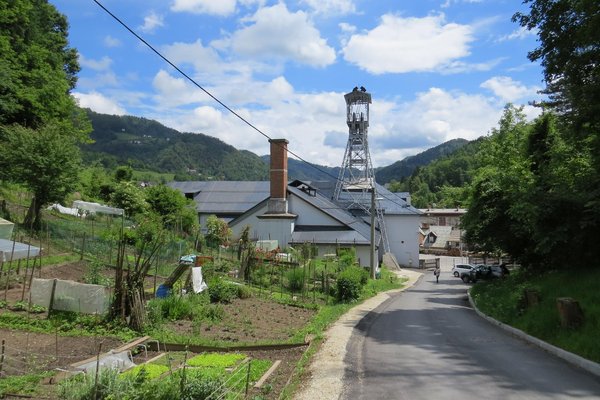Slovenia, Spain
Heritage of Mercury
“Heritage of Mercury. Almadén and Idrija” comprises what were the two largest mercury mining centres in the world.
Spanish Almadén and Slovenian Idrijia produced the rare metal over a lengthy period. They became of strategic international importance due to the need for mercury in the process of extraction of silver and gold by the Spanish in America. The sites include the mine shafts, technical infrastructure and the mining towns.
Community Perspective: Idrija comes as a pleasant surprise to many and warrants a whole day. Solivagant is the only one so far to review Almadén.
Site Info
Official Information
- Full Name
- Heritage of Mercury. Almadén and Idrija (ID: 1313)
- Status
-
Inscribed 2012
Site history
History of Heritage of Mercury
- 2012: Inscribed
- Inscribed
- 2010: Deferred
- As The Mercury and Silver Binomial on the Intercontinental Camino Real. Almadén, Idrija and San Luis Potosí (Mexico)
- 2009: Referred
- 2009: Revision
- Successor to former TWHS Mining town of Idrija (Slovenia's T List 1994)
- Type
- Cultural
- Criteria
- ii
- iv
Links
- UNESCO
- whc.unesco.org
- Official
-
- parqueminerodealmaden.es — Minas de Almadén
- visit-idrija.si — Idrija
- Related
-
- muzej-idrija-cerkno.si — Idrija museums
All Links
UNESCO.org
- whc.unesco.org — whc.unesco.org/
Official Website
- parqueminerodealmaden.es — Minas de Almadén
- visit-idrija.si — Idrija
Related Resources
- muzej-idrija-cerkno.si — Idrija museums
News Article
- Jan. 22, 2017 english.sta.si — Restored Idrija smelting plant opens to visitors
Community Information
- Community Category
- Secular structure: Mines
Travel Information
Not for Acrophobes
Extremadura Hotspot
Trieste hotspot
Recent Connections
-
European Route of Industrial Heritage
Almadén Mining Park World Heritage Site…
-
Dubbed as another WHS
Idrija - the sluices are called "Sloven…
-
Not for Acrophobes
Klavže na Belci water barrier
Connections of Heritage of Mercury
- Trivia
-
-
Dubbed as another WHS
Idrija - the sluices are called "Slovenia's pyramids"
-
Furthest distance apart
Almaden - Idrija (2198 km) -
Built or owned by Germans
Idrija's Town Hall was built by German-born architects Clemens M. Kattner and Gustav Adolf König. -
Depicted in Mizielinska Maps
Anthony's ShaftSee i.pinimg.com
-
- History
- Ecology
-
-
Liquid Mercury
Both Almaden and Idrija contain furnaces which produced liquid mercury from crushed cinnabar (E.g the 1720 "Forno Bustamante")
-
- Architecture
-
-
Art Nouveau
Idrija's Town Hall, built in the Secessionist style -
Renaissance
Idrija: The castle is an excellent example of massive Renaissance architecture (nom fil) -
Baroque
Idrija's Theatre and frescoes at the Gwerkenegg Castle
-
- World Heritage Process
-
-
Serial Transnational Sites
-
Reduced from broader TWHS
TWHS originally included the Camino Real and San Luis Potosi, which were separately inscribed. -
Inscribed at third attempt or more
Ref 2009, Def 2010, Ins 2012
-
- Human Activity
-
-
Historical Bullrings
Plaza de toros de Almadén (1765) -
Textiles
Idrija: The same routes used by mercury were also the trade routes for Idrijan lace, created by miners' wives from the 17th century onwards. (nom file) -
Locations for playing sport
Bullring (Almaden)
-
- Constructions
-
-
Water wheels
Kamst Water Wheel in Idrija, the "biggest still preserved wooden water wheel of this type in Europe" -
Prison
Almaden - "After the Fuggers failed to meet production quotas in 1566, the King of Spain agreed to send 30 prisoners to serve their sentences as laborers at Almadén. The number was increased to 40 in 1583. The prisoners, known as forzados, were selected out of criminals waiting for transport to the galleys in the jail of Toledo. Those selected usually had limited sentences and good physical abilities. Murderers and capital criminals were rarely selected, as the galleys were considered a far harsher punishment than the mines of Almadén" Wiki) There are some remains of this period " the prisoner gallery where the criminals were led to work in the mine from the prison." and location 1313rev-003 are the archaeological remains of the "Royal Forced Labour Gaol" -
Pumping Stations
Idrija: "The newest Kamšt water pump built in Idrija and still preserved dates back to 1790. It was used to pump water from the mine all until 1948..... Using a special mast structure it pumped water from a depth of up to 280 metres. It has been preserved to this very day and is considered one of the most important technical monuments in Slovenia." (Nom File) -
Theatres and Opera Houses
miners' theatre (Idrija) -
Tunnels
Almaden - The remains of mining tunnels dating back to the 18th C complete with their brick linings. among many such remains "he Baritel of San Andres" is an enormous gallery tunnelled some 50 metres underground to hold a "mule powered" hoist. SeeSee www.efeverde.com
-
Monumental Fountains
Idrija: Fountain with miner statue (1868) -
Obelisk
In the town center of Idrija, to remember 17 miners who died in a fire -
Elevators
Almaden -
Hospitals
San Rafael Miners
-
- WHS on Other Lists
-
-
Global Geoparks
2013 - Idrija Global Geopark; Calatrava Volcanoes. Ciudad Real (2024)See ens-newswire.com
-
IUGS Geological Heritage Sites
The giant mercury deposit of the Almadén syncline -
European Destinations of excellence
Idrija (2011)See ec.europa.eu
-
European Heritage Label
-
European Route of Industrial Heritage
Almadén Mining Park World Heritage Site (Link)
-
- Timeline
-
-
Built in the 16th century
The Spanish royal treasury acquired a monopoly in these activities in 1559. The Habsburgs then took direct control of the Idrija mines in 1575. (AB ev) -- Almadén is much older, but the heydays of both mines started due to the geopolitical circumstances in the 16th century
-
- WHS Hotspots
-
-
Extremadura Hotspot
Almaden -
Trieste hotspot
Idrija lies across the Schengen border with Slovenia. Trains take 2h30
-
- Science and Technology
-
-
Mines which can be visited underground
Mercury ,Almaden (elevator in, railway out); Idrija part in Slovenia - mercury mine accessible with guide on foot.
-
- Visiting conditions
-
-
Not for Acrophobes
Klavže na Belci water barrier
-
News
- english.sta.si 01/22/2017
- Restored Idrija smelting plant ope…
Recent Visitors
Visitors of Heritage of Mercury
- AC
- Adam Hancock
- Afshin Iranpour
- Alexander Barabanov
- Alexander Lehmann
- alicemears
- Aljaz
- A. Mehmet Haksever
- Ammon Watkins
- Anna Wludarska
- Antonio J.
- Argo
- Ask Gudmundsen
- Astraftis
- Atila Ege
- Bamse
- basementonline
- BaziFettehenne
- Bin
- Brendan Carroll
- Can SARICA
- Carlos Sotelo
- Caspar
- Chantal den Haan
- chenqtao
- Cheryl
- Christian Wagner
- Christravelblog
- Claire Bradshaw
- Clyde
- Corinne Vail
- Cristina Erba
- Csaba Nováczky
- Dagmara
- Daniela Hohmann
- Daniel Chazad
- Dan Pettigrew
- David Berlanda
- Dorejd
- Dr. Caligari
- Dwight Zehuan Xiao
- Echwel
- Elaine McArdle
- Elia Vettorato
- Elisabeth Fransisca Situmorang
- Els Slots
- Emilia
- emvcaest
- Erik Jelinek
- Errol Neo
- Eva Kisgyorgy
- Fan Yibo
- Farinelli
- Filip Murlak
- Frederik Dawson
- FS
- Gary Arndt
- George Gdanski
- Gernot
- Harald T.
- Harry Mitsidis
- henrik_hannfors
- heywhatever2
- Hubert
- Iain Jackson
- Ian Cade
- Ivan Rucek
- Jakob F.
- Janina Lehmann
- Janos
- Jan-Willem
- Jarek Pokrzywnicki
- Jasam
- Jean Lecaillon
- Jens
- Jezza
- João Aender
- JobStopar
- Joel on the Road
- Jonas Kremer
- KarenBMoore
- Kasia M.
- Kbecq
- Ken DJ
- Knut
- krtek
- Lara Adler
- Lisu Marian
- Little Lauren Travels
- Loic Pedras
- Luboang
- Luis Filipe Gaspar
- Lukasz Palczewski
- Maciej Gil
- MarcoB_0
- Martina Rúčková
- MaxHeAnouBen
- MaYumin
- MH
- M. Huineman
- Mikko
- MMM
- Mohboh
- MoPython
- nan
- Nihal Ege
- PabloNorte
- Patrik
- Paul Schofield
- Peter Lööv
- Petteri
- Philipp Leu
- Philipp Peterer
- Porcho
- Priyaranjan Mohapatra
- Rafał Kałczuga
- Randi Thomsen
- Riccardo Quaranta
- Roger Ourset
- Roman Bruehwiler
- Roman Raab
- Samy G
- Sergio Arjona
- Shandos Cleaver
- sibariam
- Solivagant
- Stanislaw Warwas
- Stefan Loov
- Svein Elias
- Szabolcs Mosonyi
- Szucs Tamas
- Tamara Ratz
- Taotao Chen
- Tarquinio_Superbo
- Tevity
- Thomas Buechler
- Thomas van der Walt
- Thorben
- Tim Allen
- Tom Flaten
- tony0001
- triath
- Tsunami
- usagi1974
- Vanessa Buechler
- VB73
- Vincent Cheung
- VLabhard
- Walter
- Westwards
- WILLIAM RICH
- Wojciech Fedoruk
- Wo_ko
- YaroMir
- Yevhen Ivanovych
- Yongcheng Liu
- Zizmondka
- Zoë Sheng
Community Reviews
Show full reviews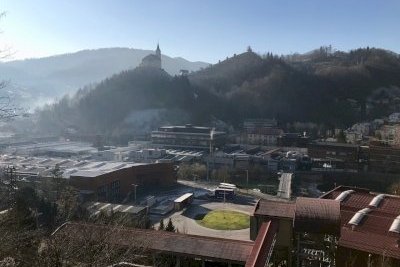
Idrija is full of surprises: We drove there as a day trip from Ljubljana. It is about a one-hour drive through gorges and on curvy streets and then you arrive in a modern, not very appealing industrial town at the confluence of the rivers Idrijca and Nikova. Since the site was in a working state up to the 90s of the last century not much of the 500-year-old industrial history is visible on first sight. Most prominent is the miners church on a hill (mostly closed) and adjacent to it a tiny “sacred mountain” with equally tiny chapels. But there are quite many things to see and it turned out that a day trip is fare too short to cover it all. I found it very hard to figure out opening times beforehand so it was not easy to figure out the best way and order to explore the different sites: There are two big museum and at least two small ones, that have opening times: The town museum in the “castle” and the rather new museum in the 20th century smelting plant, further the old Antony mine and the Kamst/pump. Since the town museum had longer opening hours we went first to the Smelting plant: The modern reception building seemed abandoned but there was big hall with an exhibition about mercury and we started looking at the displays. What seemed first a bit dry and complex turned out to be very fascinating: Nobody of us was aware what important …
Keep reading 0 comments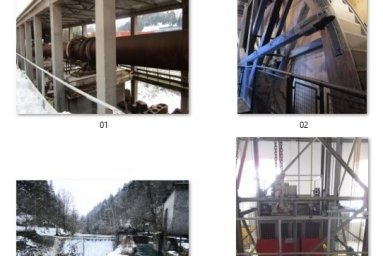
I took a bus from Logatec to Idrija, but the bus stop was not at the Logatec train station, and the closest bus stop to the train station was here: 45°55'01.8"N 14°13'26.9"E
I spent about 22 hours in Idrija, from 13:30 on Monday to 11:45 on Tuesday in February. It was a busy 22 hours, which made the visit more fun for me.
When I got off the bus one stop before the Idrija bus station, the driver asked me where I'm going. I said "To the museum," and he said "The (Castle) Museum is at the next stop." I had meant the Smelting Plant Museum, which the driver was not aware of.
As it turned out, the Museum at the Smelting Plant opened only a year before. When I got to the Museum at 13:45, I was the only visitor, and the attendant kindly gave me a tour of the Plant and even served me a cup of coffee while I browsed through the exhibition. I was especially surprised to encounter the section of the exhibition about the mercury poisoning at Minamata, Japan, which I grew up hearing about, and how the problem in Minamata made the difference with regards to mercury around the world, just as the problem in Fukushima made the difference with regards to nuclear energy around the world recently. We humans learn by making mistakes... I spent about 90 min. at the Plant Museum.
My next plan was to visit the Kamst before it closes …
Keep reading 0 comments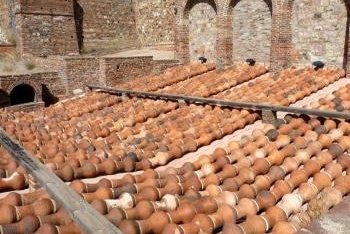
The map in my 1998 (!!) version of Michelin Spain has an enormous area bounded by Toledo, Merida and Cordoba, totally devoid of any sites deemed as being of interest by that august publication - and Almaden lies slap in the middle! Now, to be fair, the mercury mine was still operating then - it closed around 2002 and has since been turned into the “Parque Minero de Almaden”, achieving WHS status in 2012. I don’t know if the latest version still ignores it but I can state that we found the diversion off Spain’s normal tourist route into Michelin terra incognita very well worthwhile.
In our (successful!) attempt to take in 30 new WHS on the Iberian peninsular by rent-a-car in 3 weeks we always had to take great care to try to plan around that perennial problem of visiting sites in Spain – the “Cerrado” sign!! It is all too easy to arrive too early, too late, during siesta time or on a Monday or some other closing day. We were also traveling across the change from summer to winter hours. Other reasons for closure of significant sites which we came across during our trip included – an election, a wedding and the guide hadn’t turned up. As with so many Spanish WHS, visits to Almaden are only possible on group guided tours. We were already used to arriving at “opening time”, buying a ticket and then sitting around for an inordinate period waiting until …
Keep reading 0 comments
I visited the Slovenian part of this WHS. Idrija lies just enough off the beaten track to be an authentic surprise. The town has a certain cuteness that stems from constructions that were made during the mining boom of the last centuries. As a reminder that this is no open-air museum, this is mingled with some communist-style housing blocks and rather busy traffic. The best though is its natural setting: in a valley surrounded by green mountains on all sides, with a river and streams running through town. I could not find a parking spot in the city center, so I left my car at a supermarket on the outskirts of town and had a pleasant walk along that river into the center.
The first stop on my sightseeing tour was the Gwerkenegg Castle. Though it looks like some feudal lord lived here, this Renaissance building was made to be the administrative headquarters of the mine. It now houses the excellent town museum. The entrance costs 3.5 EUR and includes a booklet in English detailing all rooms. In one of the first, a bowl full of mercury is shown, with an iron ball floating in it (mercury is 2 times heavier than iron). Interesting stuff. Other rooms include one full of black-ad white photos of daily life in Idrija in the early 20th century. We see girls lace-making at school, that other craft that Idrija is famous for. The women in town started doing this to earn some additional …
Keep reading 0 comments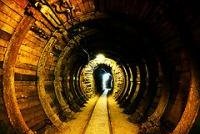
I visited Idrija, Slovenia in April 2014. I wasn't expecting much as I'm not so keen on industrial WHS. However, I was pleasantly surprised with Idrija. It is quite remote and you won't visit by chance, that's for sure. It's a nice drive through winding roads and it has much to offer even though it appears to be a ghost town now. The industrial landscape is immediately visible with metallic structures, smelting plants, mines and several shafts. I visited Anthony's shaft in time for the 10am tour in English (the other guaranteed tour is at 3pm). The tour in "the second largest mining site in the world" takes around 2 hours including a 20 minute informative video. You get to wear a protective waterproof miner suit and a hard hat before entering the mercury mine. The guide makes the trip interesting and describes the miners' everyday life as well as the different developments over time. The highlight of my trip was actually seeing naturally occuring mercury droplets in the mine as well as getting to appreciate the different structures (wooden and iron) used to support the shaft. For those who are more adventurous, group tours can be organised to go even deeper inside the shaft with torches instead of electricity lighting and going down ladders apart from the 500 stairs you go down in the traditional tour, eventually getting out in the nearby village. The traditional loop was more than enough for me to grasp the size and importance of …
Keep reading 0 comments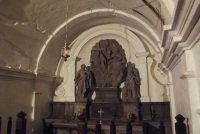
After catching the 08.15 bus from Ljubljana station to Idrija, I reached the Antony Mine in time to get kitted up for the 10.00 tour of the mine shafts.
The tour descended only 3 of the 15 levels, but the atmosphere was stifling all the same. Down in the tunnels there were several displays showing methods of mercury extraction over the centuries. There was also a rock face with drops of mercury oozing out of it.
Like Ian I also enjoyed a plate of Idrija zlikrofi (mushroom ravioli) after the tour.
Keep reading 0 comments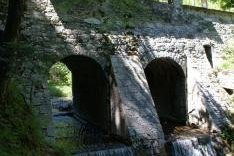
I visited Idrija, the Slovenian part of the WHS, in May 2012, expecting that it would be inscribed a few weeks later. Idrija is a small town with about 6000 inhabitants, 50 km from Ljubljana on the junction of the subalpine and the karst areas. The town lies in a picturesque valley surrounded by forest, quite unusual for a mining town. Mercury was mined for 500 years and until its closure Idrija was the second largest mercury mine, Almadén being the first. The WHS consists of seven parts: the old town, two other sites in the vicinity of the town centre, and four water barriers located in the surrounding mountains.
The historic mine, the Anthony's Shaft dating from 1500, is situated in the old town and is open to visitors. The guided tour takes 1.5 hours, it starts with a 20 minute multivision presentation. The oldest mine galleries are narrow and you have to bend down several times, the newer mine tunnels are wider and higher. The different steps of mercury mining and the techniques and tools that were used over the centuries are explained. And you can also see the underground chapel dating from the 18th Century. It was interesting to learn about the specifics of mercury mining. The mercury ore deposit is relatively small: 1500 m long, 600 m wide and 400 m deep, just below the town. In Idrija the metal was found both in its elemental liquid form and as cinnabar ore (mercury sulfide). However, the …
Keep reading 0 comments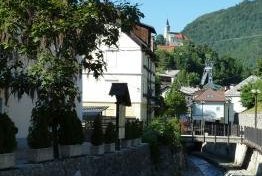
“…and if I hire a car I could make it to the disused mercury mine!” little did I know that this ‘obscure’ holiday destination that I was trumpeting in the pub would prove to be such a rewarding target.
I drove to this site fresh from landing at Trieste airport, initially just assuming I would be getting in a pre-emptive tick on a site that was soon to be inscribed on the World Heritage list and little else. It actually turned out to be an exceptionally rewarding way to start my holiday in this great little corner of Europe.
Idrija is situated in a wonderfully verdant valley and the road through it was a pleasure to drive. When I arrived at the town I was suitably impressed. Rather than being the slightly utilitarian mining landscape I was expecting it was actually a rather pretty Central European renaissance town. There were lovely winding streets, trickling streams, a little white church nestled above the town and an imposing arcaded castle housing the wonderful town museum.
I arrived just too late for a tour of the mine shafts, so headed for the museum which was exceptionally well presented, and the staff were superb. They gave me an introduction to the life of the town, its heritage and its highlights. There were displays on mercury (including a bowl full of it with an iron canon ball floating atop it), mining, technology, local art, WWI, socialism and lace. Actually the Lace display proved to be …
Keep reading 0 comments
